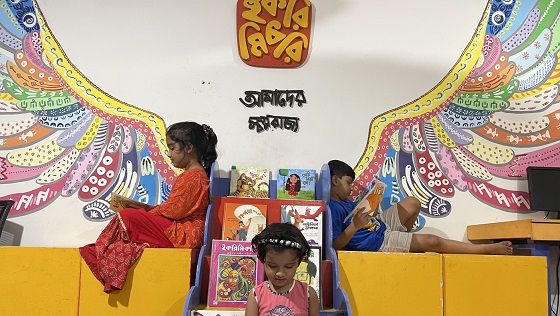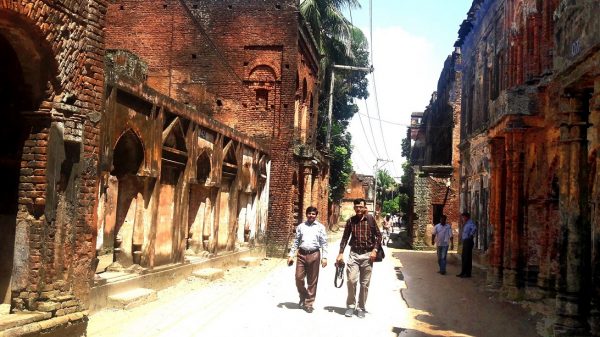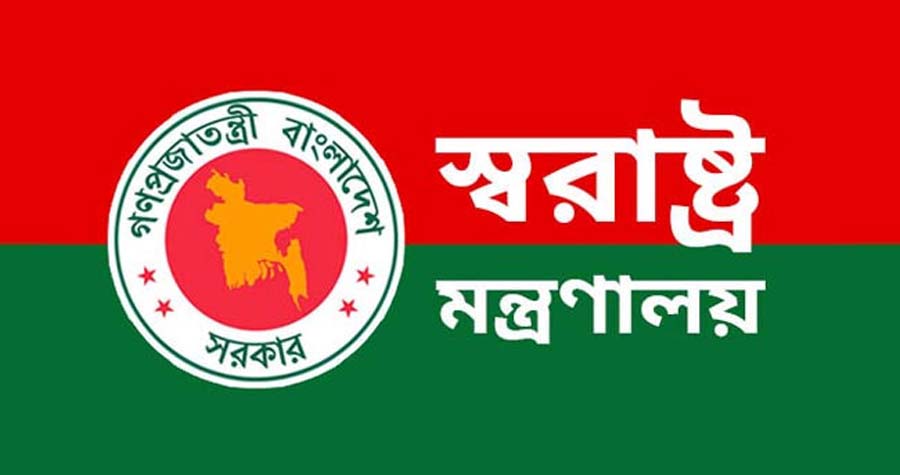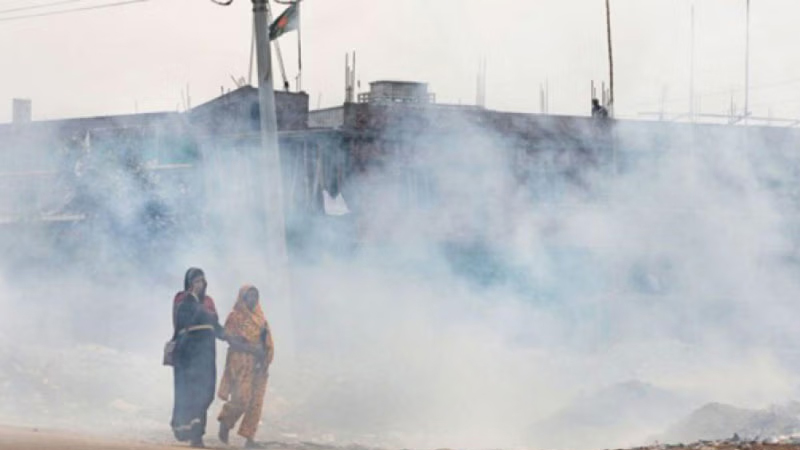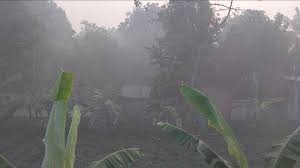Crafting and publishing a children’s book means taking a lot of things into consideration, such as the content and message of the stories, as well as the quality of production. But are parents willing to bear the expense of the effort that goes into it?
Capkata, a scary invisible being, is out there. So, Dipu and children like him are not allowed to go outside alone. But Dipu doesn't like to stay at home and so he goes out and befriends the strange thing named Capkata.
This storybook belongs to six-year-old Rouja. The pages of the sturdy paperback book have been turned so many times and in so many places that it has lost its shine. But you can't blame her for that.
With big colourful illustrations, smooth pages and big letters - the entire book is a treat for the eyes, especially for young ones. Most importantly, Dipu is of brown skin, like Rouja is, which is an important element for a Bangladeshi child to feel represented in literature.
Capkata is an Ikri Mikri production, a children's books publishing house in Bangladesh. Starting in 2016, Ikri Mikri has published almost 70 books and sold almost 20,000 copies in the last five years.
"Most of these books are unique, with new stories and illustrations, created by homegrown writers and artists," said Mahmudul Haque, the publisher of Ikri Mikri.
Mayurpankhi is another publishing house that has been working with children's literature in Bangladesh since 2012, according to publisher Mitiya Osman.
Mayurpankhi's 'Babuibela' is a favourite among grown-ups as well. Written and illustrated by Reesham Shahab Tirtho, this illustrated book features the journey of the writer's experiences of fatherhood.
On their website, they have more than 130 books in Bangla and English. Besides, the publishing house has books in Chakma, Marma and Tripura languages.
Apart from modern publishing houses like Ikri Mikri and Mayurpankhi dedicated to children's literature, there is the Bangla Academy and Adorn publications who have been publishing children's books and magazines for a long time. These publications have been quietly transforming the nature of stories consumed by Bangladeshi children; bringing them much closer to our native cultural mores.
However, of late, these publications have become pricier. For example, the price of Ikri Mikri books range from Tk100 to Tk250, while for Mayurpankhi books - story books to illustrated books - the price ranges from Tk100 to Tk700.
In a pandemic and an inflation-struck country, are the parents willing to pay for these books?
Children's books of the past
Mitiya Osman reminisced about her childhood while talking about her publishing house. She said, "during the 1970s, 80s and 90s, there were Russian story books that the former Soviet Union published. Pragati and Raduga publishers published some of the most stunning children's literature in Bangla. Nani Bhoumik, Hayat Mamud, Arun Shome, Dwijen Sharma and many other prominent writers translated those books."
And not just these, American comics and illustrated books were also available in the book market. Swandesh, Shishumela, Anondomela, Shuktara, different comics [and more] came from India. Aesop's fables were another great addition to literature.
"Apart from the translated literature, there were home-grown Bangla children's magazines like Dhan Shaliker Deshe, Shishu Potrika by Bangla Academy, Nobarun [and more]," said Manob Golder, an artist and children's book illustrator.
Illustrations by artists Hashem Khan, Quaiyum Chowdhury, Rafiqun Nabi and others adorned the pages of these magazines. And the contents were also interesting. Prominent writers Showkot Osman, Showkot Ali, Shahriar Kabir, Syed Shamsul Haque, Alauddin Al Azad, Abul Kalam Shamsuddin, Bonde Ali Miah, Ali Imam, Hayat Mamud, Abul Khayer and many more writers wrote stories and novels for children and teens in those magazines.
"We didn't have this many coloured books back then; they were mostly bi-coloured books. But you would be amazed to see what content was produced back then," said Manob.
"The quality was so good that today, in 2022, I feel like we have had a disappointing fall," added Manob.
Resonating with Manob, Sadia Jafrin, founder of Grow Your Reader foundation opined that lately there has been a huge void in this sector, especially in the last decade.
"Even 5/6 years back when we searched for children's books in the market, it was just Thakumar Jhuli, children's collection by Sukumar Roy and Upendrokishore Roy, Adorsholipi or the alphabet learning books and Bangla rhyme books. At best, we had translated Disney books or the Grimm brother's story collection. We rarely had our content for the modern generation children'', she said.
Sadia and her team run programmes where they take books to young readers in slums and roads. They also publish books where they commission young writers and illustrators to write and design.
A quiet shift
As publishers are now coming forward with new ideas and content, the situation is improving, according to Sadia.
"The social mores and ideologies, environment - everything has changed. This generation has newer challenges to focus on - climate and environmental, socio-political, and economic. So how can we educate children of this generation just with the books our parents or we had read?" explained Saida.
Sadia's foundation prefers stories from which children can garner social-emotional learning, learn about food and nutrition, sustainable living and environment - mainly books that empower children and give them a perspective about life.
"These topics need to be discussed now, as children may face problems [pertaining] to these issues, especially the urban ones, who don't get to spend much time with their peers beyond social media," Sadia said.
Children, especially urban children nowadays, are stuck at home and are more and more attached to gadgets. To 'rescue' them from this phenomenon, parents want to give them books.
Publisher Mitiya Osman said, "Parents who are educated and are from middle to the upper-middle class who can afford to pay money for the books, are buying books. Mothers are especially our primary consumers."
Nahfia Jahan Munni, an illustrator and artist, says that families that live abroad want to buy Bangla books for their children to introduce them to the language. For them, the book must be of good quality to match up to the international market.
Consumer vs customer
Rubaiat Saky, a journalist and a mother of two, said that her 5-year-old son is curious about all kinds of sea creatures, marine life and fairy tales. So when she is about to make a purchase, she looks out for three things: the books should have colourful pictures, the language should be easy and the books should be sturdy but not so much that it hurts the child.
"The tricky part of publishing a children's book is that although it is for the children, the buyers are parents. The requirements that the parents have may not be what children want. [For instance big letters], do the parents ask their children if that's what the children want or not? [Or] what books do they want?" said Hasan Tarec, one of the publishers of Dyu publications, who publish palm-top sized children's story books to appeal more to children.
"While toddlers and children up to 13-year-old like textless picture books and illustrated books, young adults of Bangladesh above 13 to 17 years are fond of teen adventures and novels, although it varies according to socio-economic status and the curriculum they are studying in," Tarec said.
Mahbubul Haque, the publisher of Ikri Mikri, said that children's books are extremely sensitive to work on. Because, unlike grown-ups, children and teenagers have impressionable minds, almost like a sponge - not mature or strong enough to filter out information that is not appropriate. So a lot of effort and thought process goes into making one of these books.
For example, murder and hunting may seem normal for grown-ups like us. But it's not appropriate for toddlers.
In 2018, one of Ikri Mikri's story books sold more than 5,000 copies, which was a great success in terms of children's literature in Bangladesh. But after the Covid-19 pandemic and the current inflation, book sales have decreased.
"Children's literature does not count as our basic needs. It gets really tough to maintain international standards. The amount of effort and quality check that goes into a good quality book increases the price. Internationally, schools and academies are the big buyers of these books, where they are also kept in libraries," said Mahbubul.
Ensuring quality
Diponkar Chakroborti writes stories, rhymes and poems for children. He says there are good quality books in terms of illustration and binding, but the writers are still stuck in an archaic pattern of narrative writing.
"Especially the poets. When they write for children, they can't get out of describing a village, flowers, seasons, or nature. The writers somehow don't recognise the modern child's problems or challenges, their loneliness, depression."
Sadia Jafrin says that there are many writers out there but not many think about children psychology.


